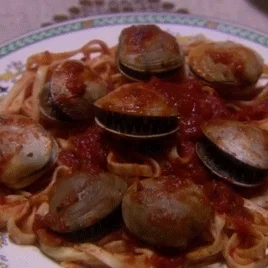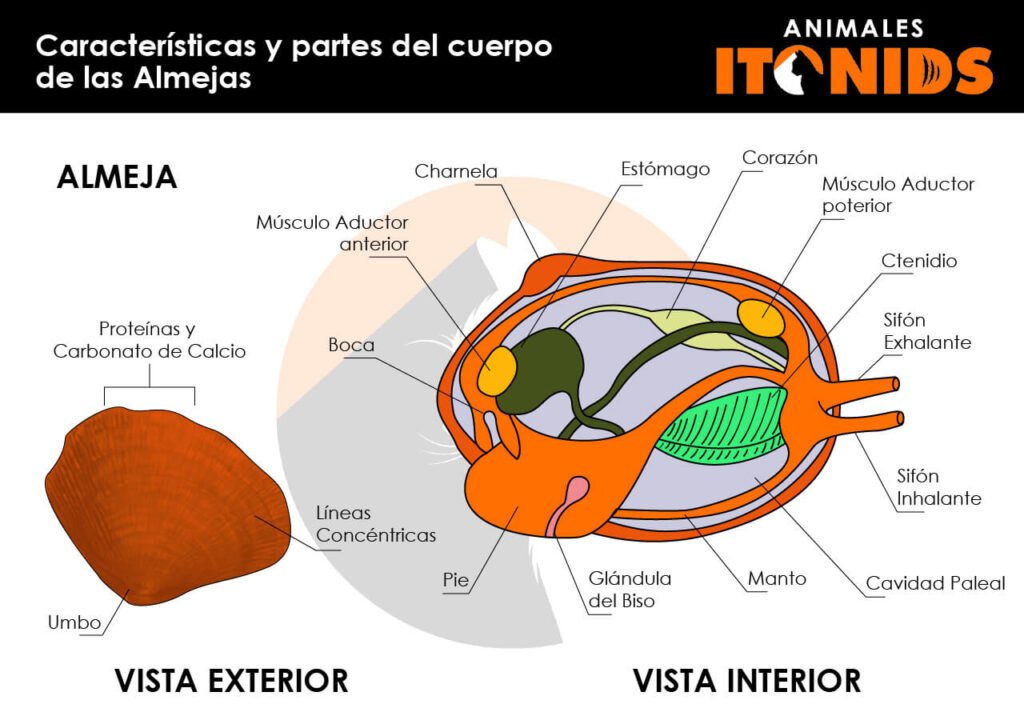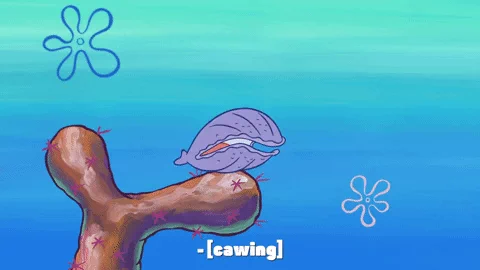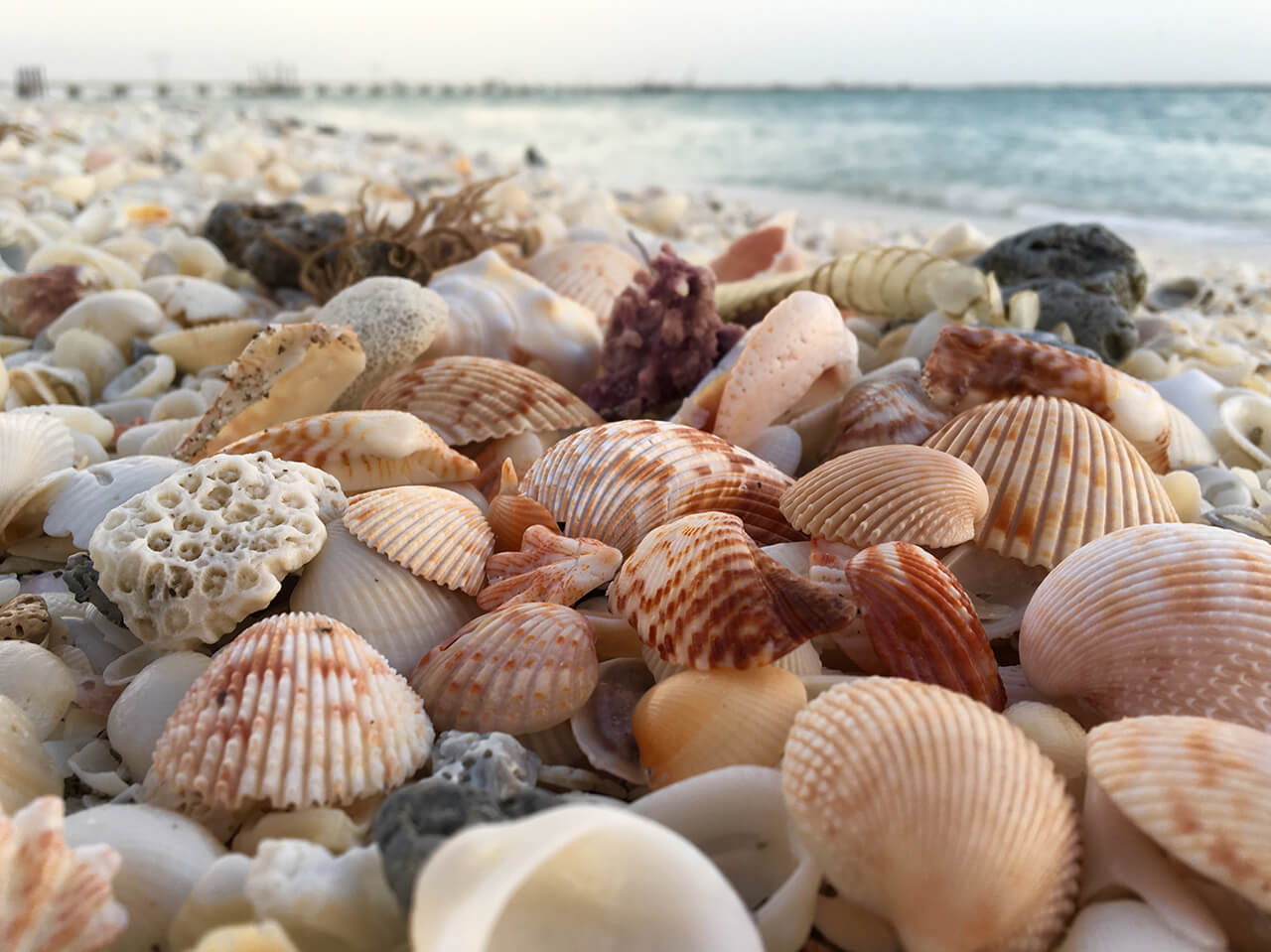By the seashore, or buried in sandy and muddy bottoms of rivers and lakes, stands out a fantastic group of animals called “clams,” which are part of the mollusks, that is, animals with a shell.
With more than 12,000 species distributed around the world and known for millions of years, they have optimally adapted to different marine habitats, distinguishing between marine clams and freshwater clams.
A shell that can open and close, a muscular foot for attachment, and the ability to produce pearls are just some of the fascinating characteristics of this group of animals.
Do you want to know in detail what they are like, what they feed on, how they reproduce, and which species can produce pearls? Keep reading and we will tell you everything…
What are clams?
They are a group of aquatic animals (both marine and freshwater) belonging to the phylum (division) of “mollusks,” class Bivalvia, that is, animals with a shell or carapace formed by two valves (plates), of various sizes and colors.
They are also known by the name of “Lamellibranchs,” for having gill in the shape of lamellae, and “Pelecypods,” for having a foot shaped like an axe.
Did you know…? The lifespan of these animals is quite high, so much so that there are some species that can live for more than 200 years; however, there are others that only last a year.

Characteristics of Clams
External Anatomy
- Soft, flattened body, protected by a shell (external skeleton) that separates into two oval halves or “valves” of equal or different size, and move together thanks to an elastic band (ligament), and a series of grooves or teeth (hinges).
- The teeth are distributed in the area of the joint or hinge, ensuring they fit together when opening and closing, and are joined at a point located on their dorsal part called “umbo.”
- The valves are formed by a substance secreted by the animal (calcium carbonate) originating three layers: inner (hypostracum) composed of a slimy substance (nacre); middle or shiny and outer (or periostracum), rough and of a yellowish-brown color.
- They have no head or eyes, and have two pairs of tongues, called “labial palps” that surround the mouth and allow the introduction of food.
- They have a well-developed organ (muscular foot) in the belly area, useful for digging into the substrate and clinging to rocks, thanks to an elastic substance (byssus) that it expels from the middle of the foot.
- Depending on the species, they present variable sizes (between 0.1 millimeters and 1.8 meters).
- They are generally gray with dark spots, and the shell may show lines or marks representing periods of growth.
Did you know…? “Sclerochronologists” are scientists who study the growth and age of clams from the lines on their shells, and can thus obtain useful information about environmental conditions to reconstruct the history of past climate.

Internal Anatomy
The soft body is covered with a tissue or “mantle” that joins to the edge of the shell (pallial impression).
At the back of the mantle, there are two tubular structures (siphons) through which water circulates, one inhalant (entrance) and one exhalant (exit) and include at the tips small tactile tentacles.
The deeper the clam is found, the longer its siphons; these can be stored in a kind of pocket, called “pallial sinus” so the valves can close.
Respiratory System
The respiration of clams is gill-based, through two organs (external gills or ctenidia) located on either side of the body, in the form of thin sheets arranged one above the other, through which water circulates for gas exchange and food filtration.
Digestive System
Comprised of the mouth, esophagus, stomach, a small dark mass (liver), and an opening that leads to a curved intestine and extends to the foot to end in the anus.
Circulatory System
The circulatory system of clams is simple, with a heart located in a small transparent sac, which pumps blood to the body, and a system of veins through which the blood circulates back, generally colorless or with green or bluish tones (hemocyanin).
Certain species that live in places where there is little oxygen (mangroves) possess hemoglobin, and therefore, their blood is reddish (due to iron content).
Nervous System
They have no brain; however, they possess a system of soft nerve cords, which controls the information collected through tactile sensory organs and chemoreceptors (chemical changes), located in the foot (statocysts), the edge of the mantle (tentacles), and the viscera.
They have no hearing or taste, and do not emit any kind of sound.
Muscular System
Clams have two large fibrous muscles, called “adductors” (anterior and posterior) attached to each end of the valves (pieces), allowing their movement.
Reproductive System
They are species with separate sexes, the female has eggs and the male, sperm, although there are species that can be hermaphrodites (possessing both reproductive cells).
How do clams reproduce?
Their reproduction varies depending on the species. Marine clams reproduce through external fertilization; the female releases eggs into the water to be fertilized by the male, who expels sperm through his exhalant siphon (opening).
Subsequently, the eggs hatch (break) to give rise to a larva (veliger) that will swim among the currents until reaching the seabed, moving with its muscular foot to find the ideal site and settle permanently.
Once there, it begins its process of metamorphosis (changes), until it becomes an adult clam.
In freshwater clams, fertilization is internal; the female keeps her eggs in a region (marsupium) of the gills, and sucks in, through the inhalant siphon (opening), the sperm released by the male into the water to carry out fertilization.
After several weeks, the larvae are released into the water, needing to become parasites (usually fish), until reaching the adult stage and adopting a free-living lifestyle.
Did you know…? The species “Lissarca miliaris” that lives in Antarctica is capable of changing sex to reproduce.
Types of clams
Depending on the aquatic zone they inhabit, clams can be classified into two types: sea clams and freshwater clams.
Sea Clams
They live in saltwater, buried in sandy bottoms at an approximate depth of 5 to 30 centimeters, adapted to a temperature of 5 ºC to 35 ºC, which allows them to withstand the phases of low tide.
The yellow clam (Amarilladesma mactroides) and the Japanese clam (Ruditapes philippinarum) are representative species.
Freshwater Clams
They inhabit the soft or muddy bottoms of lakes, lagoons, and rivers, moving with their muscular foot and leaving tracks in the sediment. They are also called “naiads” in honor of the mythological nymphs who protect rivers and streams.
“Diplodon chilensis” and “Diplodon granosus” are species of freshwater clams.

Where do clams live?
They are distributed all over the world; buried under mud or sand, in shallow marine waters, or semi-buried at the bottom of lakes, lagoons, and rivers, although some species have been found at depths of more than 4,800 meters.
Upon reaching the adult phase, they adopt a sedentary (fixed) lifestyle.
Did you know…? Clams offer shelter for small worms and insect larvae.
What do clams eat?
Their diet includes algae, protozoa, bacteria… they also consume detritus (fine particles of dissolved organic matter).
To feed, they filter water that enters through the inhalant siphon (opening) through the gills (respiratory organs); the obtained food is mixed with a type of mucus, creating a food bolus that is then directed towards the mouth.
Wastes are expelled with the water current that exits their body.
Did you know…? Clams can sort their food before passing it to the mouth using the labial palps (tongues) to decide whether to eat or discard the food bolus.
Clams with Pearls
In freshwater rivers and ponds, live clams capable of producing pearls inside their bodies!
The creation of this hard, shiny, and highly valued object occurs when a foreign body (parasites, small marine animals…) is introduced inside them (mantle), triggering an immediate expulsion response or the release of a substance (nacre) to cover it.
The result is small pearls made of calcium carbonate, irregular in shape and dark in color.
The species “Margaritifera auricularia” inhabits the Indian Ocean and is known as the giant river pearl clam. Currently, the freshwater pearl market is led by China.

